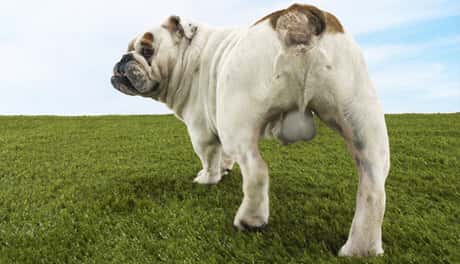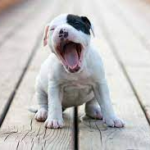
Why Should I Neuter my Dog?
Aside from helping control the current overpopulation of dogs, neutering a pet dog generally makes for a healthier dog and a better pet. Neutered dogs tend to live longer and have fewer behavior problems (see below). They are less likely to be relinquished to the shelter and do not contribute to over-crowding in community animal shelters with their off-spring.
That said, there are some recent studies that show waiting until a male dog is close to their full musculoskelatal size to alter them may have benefits. So, the big question is, how old should your male dog be before getting neutered?
Health Benefits to the Dog
There are several health benefits to neutering. One of the most important concerns the prostate gland, which under the influence of testosterone will gradually enlarge over the course of the dog’s life. By age five years, it is usually significantly enlarged in an unneutered male dog. As the dog continues to age, his prostate is likely to become uncomfortable, possibly being large enough to interfere with defecation. The prostate under the influence of testosterone is also predisposed to infection, which is almost impossible to clear up without neutering.
Neutering causes the prostate to shrink, preventing both prostatitis as well as the uncomfortable benign hyperplasia (enlargement) that occurs with aging.
Other health benefits of neutering include the prevention of certain types of hernias and tumors of the testicles and anus. Excessive preputial discharge is also reduced by neutering.
What Behavioral Changes Can be Expected After Neutering?
Numerous studies on the behavioral effects of neutering have been performed evaluating playfulness, fear of strangers, territorial aggression, mounting, urine-marking, roaming and other behaviors. The behaviors that are most consistently altered after neutering are inappropriate mounting, urine marking, and fighting. These behaviors were significantly reduced or completely eliminated in 50-60 percent of male dogs after neutering. Most pet owners look forward to curtailing these actions and thereby improving their relationship with the dog.
What Exactly is Done Surgically?
There are a few ways to perform this surgery. The most widely used approach is as follows: An incision is made, generally just forward from the scrotum. The testicles are removed through this incision. The stalks are tied off and cut. The tissue is then closed up. Some degree of swelling may be seen post-operatively, which generally resolves over time. The skin incision may or may not have stitches that are external vs buried under the skin.
What Can I Expect Upon Discharge from the Hospital?
The scrotum is often swollen in the first few days after surgery, leading some people to wonder if the procedure was really performed as the scrtum often appears to be as large as it was when the testicles were there. If the dog is immature at the time of neutering, the empty scrotum will flatten out as he grows. If he is mature at the time of neuter, the empty scrotum will remain as a flap of skin. Sometimes the incision is mildly bruised. Most male dogs are eager to play by the day after surgery but, to keep the incision intact and swelling to a minimum, it is best to restrict the dog from much activity.
At What Age Can Neutering Be Performed?
Male dogs can be neutered at just about any age though the traditional age for neutering is six to nine months of age, which is still before puberty. There is some controversy regarding when the best age for neutering should be: after puberty, traditional age or “early”, which can mean any age from eight weeks up to six months.
The younger the pup is at neutering, the longer his long bones will continue to grow, which changes his conformation to a taller stature. This appears to have some musculoskeletal consequences, though, and has been associated with increased ligament ligament tears. Waiting until your pooch is almost at his full size reduces this complication.
That said, surgical recovery at younger age is faster and there are fewer complications with the neuter itself. From a population perspective, shelters have had problems with adopters failing to return for neutering. For this reason, many shelters and rescue groups neuter prior to adoption to preclude the pup’s ability to contribute to pet overpopulation himself when he is older.
Senior dogs can also benefit from neutering. A diseased, enlarged prostate will still shrink down to a comfortable size even in an older dog. The neuter is a relatively simple low-risk surgery, which means that even an older dog can still benefit, although the recovery may be longer with more likely swelling and bruising.
Will he Become Over-Weight or Lethargic?
Metabolism changes with neutering in such a way that there is a moderate risk of becoming overweight after neutering if diet and exercise aren’t monitored. The dog owner should be prepared to make adjustments in diet or exercise if the dog seems to be gaining too much weight.
Will he Still Be Interested in Females?
His interest will be reduced but if he is around a female dog in heat, he will become aroused by her. Mounting behavior often has roots in the expression of dominance and may be expressed by a neutered male in a variety of circumstances that are not motivated by sexuality.
What if a Dog Has an Undescended Testicle?
Undescended testicles have an increased tendency to grow tumors. They may also twist on their stalks and cause life-threatening inflammation. For these reasons, neutering is recommended for dogs with undescended testicles. This procedure is more complicated than a routine neuter; the missing testicle can be under the skin along the path it should have descended to the scrotum, or it may be inside the abdomen.
Some exploration may be needed to find the testicle, thus there is often an incision for each testicle. The retained testicle is sterile and under-developed. If there is one descended testicle, the dog will be able to breed but since retaining a testicle is a hereditary trait, it is important that the male dog not be bred before he is neutered. It is not a good idea to pass on the retained testicle trait.
What Are the Negative Aspects of Neutering?
This turns out to be a more complicated subject to study than one might think. The issues that are typically studied are orthopedic/joint related problems and different types of cancers in a few select breeds of dogs and whether neutering a male dog truly changes the incidences of these. The Hoffman study of 2013 looked at over 70,000 canine medical records and found that neutering increases a dog’s lifespan by 14 percent. They found that neutered dogs were less likely to die of infectious diseases, degenerative diseases or trauma but were more likely to die of cancer or immune-mediated disease than their unneutered cohorts.
Upon scrutinizing different cancers, incidences are still low. For example, the risk of developing prostate cancer is several times higher in neutered dogs vs. unneutered dogs but still greater than one percent in both groups. Cancer development is more about environmental exposures and heredity/breed predispositions than about testosterone, so it has been difficult to draw conclusions.
With regard to hip dysplasia and cruciate ligament rupture, probably the most common joint problems of dogs, body condition/obesity, general size of the dog, and genetics are likely to be the major risk factors but there does seem to be an increased risk of these issues in dogs neutered before puberty when their bones are still growing and conformation is not set.


